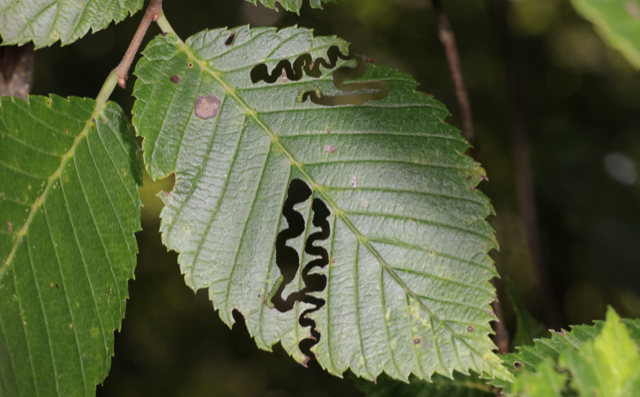Interesting insects: Zigzag sawfly bad, monarch good
A little bit of this, and a little bit of that …
If you were around in the1970s and '80s, and depending on your age, you probably heard at one time or another about the loss of 75% of the elm trees in the United States. A fungus, the result of beetles eating into the bark of the tree, devastated the species worldwide.
First discovered in Europe in 1910, by 1928 it showed up in America, the result of logs shipped from the Netherlands to be used for veneers in the furniture-making industry. And to be more specific, in Ohio furniture making operations. One interesting aspect of Dutch Elm Disease is that the tree actually kills itself in a roundabout way. In an effort to fight off the fungus, the tree blocks its xylem tissue, thus shutting off any way for the tree to pass nutrients from roots to leaves.

Now, the elm is making a comeback in the U.S., and maybe once again the landscape will be covered in 80-foot trees and their wide-sweeping canopies.
But wait.
Actually, the elm species here in Ohio has a new battle on its hand, although not enough research has been done yet to tell if it’s another death sentence for the tree. Just recently, a researcher discovered a population of the invasive elm zigzag sawfly infesting elm trees at the U.S. Department of Agriculture’s Forest Service Northern Research Station lab outside of Columbus in Delaware and in northern Franklin County. The Forest Service and the Ohio Department of Natural Resources Division of Forestry report that subsequent surveys have also located the species on nearby properties.

“Elm zigzag sawfly is an invasive insect native to Asia that was first found in Canada in 2020 and in multiple eastern U.S. states in 2021 and 2022,” ODNR Division of Forestry, Forest Health Program Manager Tom Macy said. “This is the first detection of the species in Ohio.”
According to a release from the ODNR, while capable of significant defoliation of elm trees, the overall impact of the species on forests and urban landscapes is not fully known and is an area of active research. There are no reports of the elm zigzag sawfly causing the death of elm trees. Management options for the species are still being studied. The ODNR Division of Forestry will continue to survey for the elm zigzag sawfly across the state.
If you find a suspected elm zigzag sawfly or signs of infestation, report the sighting using the free Great Lakes Early Detection Network mobile app or try to get a good photo or collect a specimen and notify the ODNR Division of Forestry at 614-265-6694.
Loss of tree species is nothing new in Ohio or the United States, from the chestnut blight (4 billion trees killed) to the devastation of ash trees. In the past 10 years alone, Ohio has lost a high percentage of its ash trees to the Emerald Ash Borer, with the number listed at 100 million trees killed in the lower 48 states.
Monarch update
We’re starting to wind down on this year’s mission to help the monarch butterfly and other Ohio pollinators here at the Holden household. It was an unusually slow year for the monarchs this summer, with the first to show up (at least that we saw) not until July 6. In some years, we had hatched butterflies by then. In fact, in 2020, we had released 21 monarchs by the end of June.
But that’s OK, because we’re way past shooting for big numbers. The goal is to collect a few and raise them to butterflies to help with educational opportunities, do some talks to spread the word, and provide needed milkweed for not only the butterflies, but for anyone who needs some in a pinch.
My wife Jean, AKA “The Monarch Whisperer,” has still been busy with her monarch nursery, watering of plants (that was several hours a day during the dry spell in June), seed collection and talks on the phone with those who have questions, but this year’s goal was to leave most of the eggs laid on our milkweed to Mother Nature. We supply the pesticide-free flowers and milkweed, and the monarchs do the rest.
Any monarchs eclosing from their chrysalis now will be the “super” generation that will soon start their migration to Mexico. They’ll start arriving in the mountains of central Mexico around Halloween, and will overwinter there until March, when they’ll start their migration back north again.
As of this writing, Jean has released 33 monarchs, and has 16 chrysalis hanging. Her success rates this summer has been fantastic, with no bad caterpillars and only one butterfly that didn’t make it (bad wing, couldn’t fly).
We’ve also had fun raising black swallowtail butterflies, which have loved laying their eggs on our dill, parsley and carrots.
Outdoor correspondent Art Holden can be reached at letsplabal@yahoo.com
This article originally appeared on The Daily Record: Elm zigzag sawfly discovered in Ohio; an update on monarch butterflies
